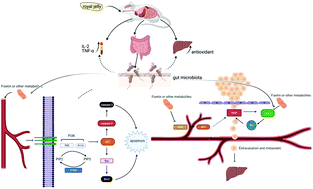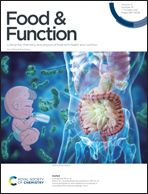Selenium-rich royal jelly inhibits hepatocellular carcinoma through PI3K/AKT and VEGF pathways in H22 tumor-bearing mice†
Abstract
Royal jelly (RJ) and selenium (Se)-rich foods have well-known health benefits that are attributable to a broad range of pharmacological effects including antioxidant, anti-tumor, and immunoregulatory activities. However, the physiological effects of Se-rich RJ, which is produced by feeding Apis mellifera (Hymenoptera: Apidae) sodium selenite sucrose solution, are not well understood. The anti-hepatoma activity and mechanism of Se-rich RJ in H22 tumor-bearing mice were investigated in the current study. The findings showed that the content of organic and inorganic Se in Se-rich RJ was significantly higher than that in RJ. Furthermore, interleukin-2 (IL-2) levels and tumor necrosis factor-α (TNF-α) production in serum were increased and the malondialdehyde (MDA) content in liver was decreased in mice fed RJ and Se-rich RJ. 16SrRNA sequencing and serum untargeted metabolomics showed that RJ and Se-rich RJ could modulate the gut microbiota, and fisetin and L-glutathione oxidized were the main anti-tumor components in RJ and Se-rich RJ. Further analysis showed 11-deoxy prostaglandin F1β was the specific anti-tumor metabolite in mice treated with Se-rich RJ compared with RJ. The results indicated that RJ and Se-rich RJ could inhibit the expression of PI3K and phosphorylation of AKT, induce cell apoptosis through the activation of caspase-9 and caspase-3, and regulate Bcl-2/Bax expression. RJ and Se-rich RJ also inhibited the expression of COX-2 and VEGF. To summarize, the findings clearly demonstrate that Se-rich RJ could inhibit tumor growth by inducing apoptosis and inhibiting angiogenesis as well as exhibit anti-tumor effects by improving immune function and antioxidant activities. The results indicated that Se-rich RJ could be a potential functional food for the management and prevention of cancer.



 Please wait while we load your content...
Please wait while we load your content...